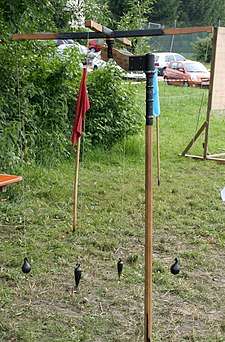Groma surveying

The Groma or gruma was a Roman surveying instrument.[1] It comprised a vertical staff with horizontal cross-pieces mounted at right angles on a bracket. Each cross piece had a plumb line hanging vertically at each end. It was used to survey straight lines and right angles, thence squares or rectangles. They were stabilized on the high ground, and pointed in the direction it was going to be used. The helper would step back 100 steps and place a pole. The surveyor would tell him where to move the pole and the helper would set it down.[2] The same name was given to:
- the center of any new military camp, i.e. the point from which was traced the regular grid by using the groma instrument
- the center of a new town, from which the gromatici (surveyors) began to lay out cardo and decumanus grid, with a plough and a pair of oxen
The groma surveying instrument may have originated from Mesopotamia, and may have been imported by the Greeks in the 4th century BC. Subsequently, it was brought to Rome by the Etruscans and named cranema or ferramentum.[3]
Notes
- ↑ Cesare Rossi, Marco Ceccarelli, Michela Cigola, The groma, the surveyor's cross and the chorobates. In-depth notes on the design of the old instruments and their use. La Groma, lo Squadro agrimensorio e il corobate. Note di approfondimento su progettazione e funzionalità di antiche strumentazioni, in Disegnare Idee Immagini, anno XXII n. 42/2011; pp. 22-33. ISBN 978-88-492-2248-7, ISSN IT 1123-924
- ↑ Lewis, M. J. T. (2001-04-23). Surveying Instruments of Greece and Rome. McGraw Hill Professional. p. 120. ISBN 9781139430357. Retrieved 29 June 2014.
- ↑ Yan, Hong-Sen; Ceccarelli, Marco (2009-01-11). International Symposium on History of Machines and Mechanisms: Proceedings of HMM 2008. Springer. p. 107. ISBN 9781402094859. Retrieved 28 June 2014.
External links
| Wikimedia Commons has media related to Groma. |